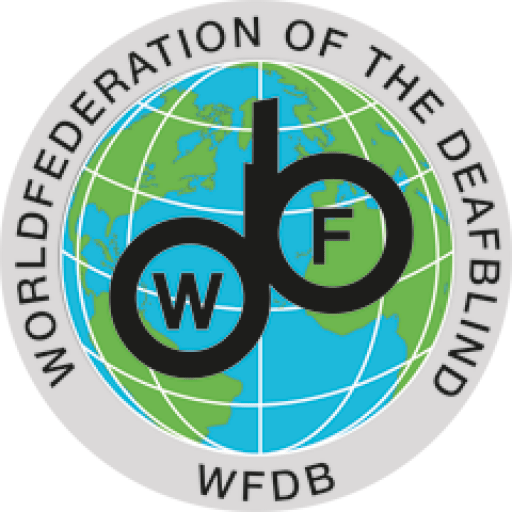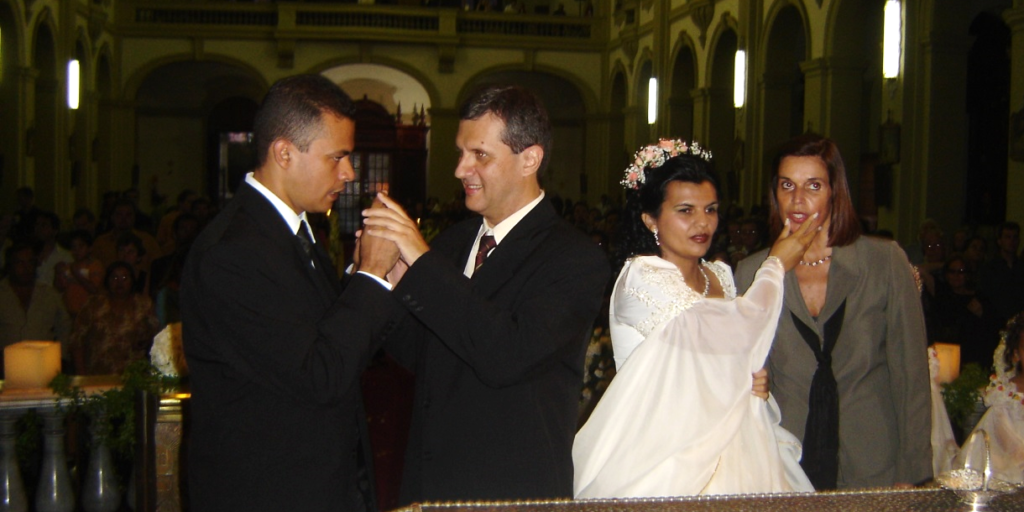WHAT DOES THE DATA SAY?
The country-level analyses provided minimal information on social life, with the exception of marital status and the presence of biological parents in the household for children.
People with deafblindness are less likely to be married than people without disabilities in all datasets except Sudan and Uruguay.
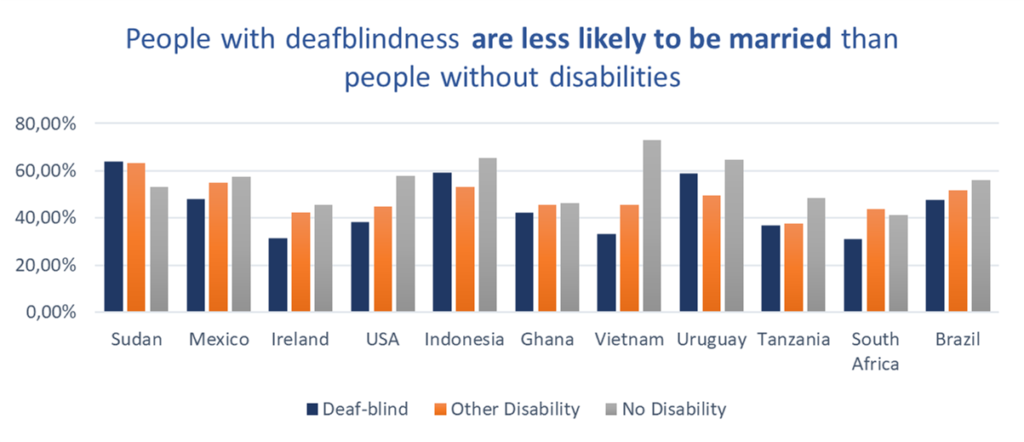
Women with deafblindness were much less likely to be married than men with deafblindness in each dataset, even after accounting for age (see Figure 10). Women with deafblindness were also statistically less likely to be married than women with other disabilities across the five datasets, and less likely to be married than women without disabilities in all datasets.
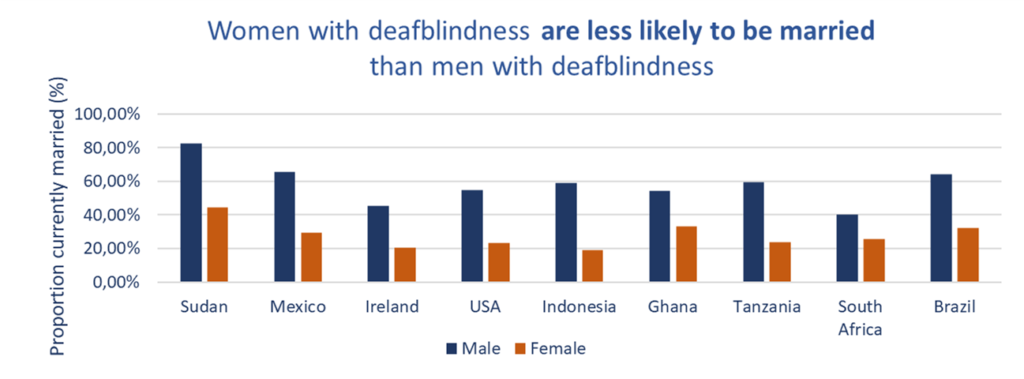
Among those aged under 18 years, children with deafblindness were statistically more likely to have at least one biological parent absent from their household in five of nine datasets (South Africa, Sudan, United States, Mexico and Indonesia) (see Figure 11). Compared to children with other disabilities, most datasets did not show any statistically significant differences, with the exception of Sudan and Indonesia, where children with deafblindness were more likely to be living without at least one parent.
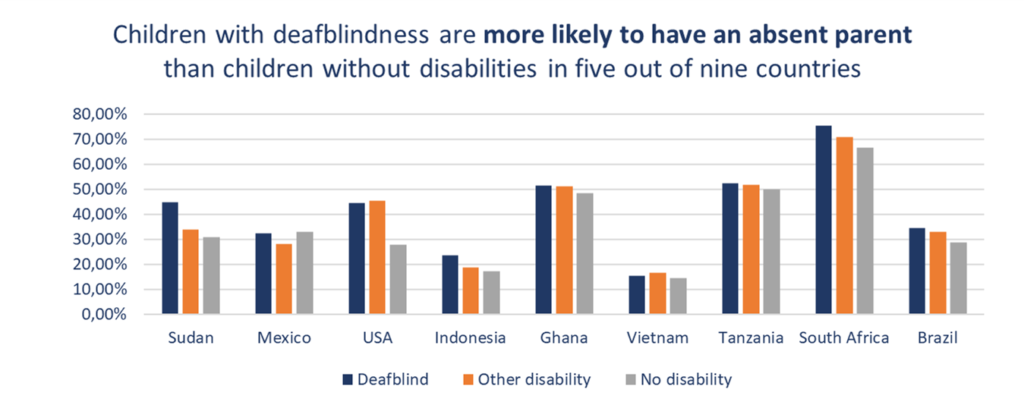
The literature review included several studies that explored other indicators related to social life among persons with deafblindness. These were mostly from high-income countries and among older adults. For example, several studies among older adults with deafblindness found that many experienced decreased participation in everyday activities [14, 41-43]. A study of older adults with deafblindness in Sweden found some chose not to participate in physical activity due to stigma, low self-esteem or other responsibilities, such as contacting health and welfare agencies [43].
Social isolation among persons with deafblindness was also a common theme in the literature. Across the 11 European countries, adults aged over 50 with deafblindness were twice as likely to be socially inactive compared to people without sensory difficulties [18]. Challenges to understanding and being understood by others were major barriers to social inclusion, which also contributed to fatigue, frustration and stress. Several studies reported a lower quality of life and wellbeing among older adults with acquired deafblindness [13, 44, 45].
OUR VOICE

Unsurprisingly considering the issues highlighted with regards to the inaccessibility of interpreter-guides, only half of all respondents from high and middle-income countries (and 40% of those from low-income countries) stated that they had access to regular community services. Discussions with WFDB members showed that accessing such services was y possible with the support of family members and that autonomous use was a serious problem. With regards to specific community support services aside from interpreter-guides, 85% of respondents from high-income countries stated that they had access to such services, compared to 33% of respondents from middle-income and 20% from low-income countries. It is clear that very few disability support services exist beyond those provided through NGO-organised community-based programmes.
Confirming the findings from the literature, WFDB members highlighted the severe isolation that most persons with deafblindness experience. A lack of accessibility, limited employment opportunities and an accumulation of barriers severely restrict the participation of persons with deafblindness.
Each individual follows a different pathway, and this is often dependent of whether deafblindness is pre- or post-lingual, and whether it is acquired at a younger or older age. In all cases, however, a lack of adequate support for a person and his or her family, the cost of assistive devices, the lack of interpreter-guide services, and the lack of rehabilitation services significantly restricts social participation and increases isolation.
WFDB members also highlighted the issues of stereotyping and a lack of knowledge amongst family members and friends, which caused isolation within family and friendship groups. Poor communication and family support can lead to issues such as violence, neglect and abuse, and, in extreme cases, persons with deafblindness may be locked away in their homes or medicated so that they sleep all day. Families may also be over protective and prevent individuals from taking risks and participating in the community. Isolation and a lack of independent living skills can result in severe anxiety amongst family members, particularly older parents who fear what will happen to their adult children after they pass away.
Due to gender-based discrimination, each of these elements is magnified for women with deafblindness, who are more exposed to abuse and sexual violence.
The very few people who master communication techniques in the environment of a person with deafblindness imply that connections are usually formed through an intermediary, such as an interpreter-guide. Awareness needs to be raised so that people, particularly community service providers, are aware of even the basic communication requirements. Typically, when persons with deafblindness retain some residual hearing and sight, people do not communicate effectively.
A lack of support for interpreter-guide services is a critical barrier across a range of countries and situations. As outlined in this report, few countries provide adequate, high quality services so that persons with deafblindness can gain a meaningful education, work and social participation. People often have to choose when to use their allocated hours of granted support and sacrifice entire aspects of their life.
More positively, WFDB members highlighted the fact that the growth of social media and accessible technology have created a raft of new opportunities through which they can interact with the world and other persons with deafblindness. This should be a major motivation for governments to ensure the accessibility of information communication technology.
Organisations of persons with deafblindness play a critical role in reaching out, stimulating and catalysing social activities that include families and communities. Unfortunately, as previously discussed, many people and their families do not benefit from the necessary support from authorities.
RECOMMENDATIONS
- Provide early intervention and counselling services for families of children with deafblindness.
- Implement community-based intervention programmes to facilitate the social participation and inclusion of persons with deafblindness.
- Ensure the adequate provision of interpreter-guides.
